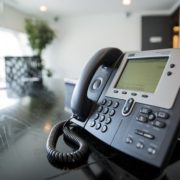Basic Business Etiquette to Be Aware Of
Individuals often feel uncomfortable in business situations, as this is one topic most business schools overlook. They don’t cover proper business etiquette at times such as this, leaving a person wondering what they should say and how they should act. Until this changes, a person may wonder if they are presenting themselves properly in this setting. Fortunately, people can learn what is expected of them by doing their own research. Following are some common business situations and how one should act in each.
Business Calls
The telephone remains an essential communication tool and not simply for the ability to check emails and send texts. Speaking to someone over the phone remains the fastest, simplest and most personal way to connect with another person. However, a failure to use proper phone etiquette can have a negative impact on the outcome of the call.

Smile when answering the phone, as this has a positive influence on your tone of voice. In addition, be sure to address the other party by name to show you value them as an individual. Talk slowly and clearly while keeping the phone approximately two inches away from the mouth to ensure you can be heard clearly and provide appropriate answers. Never use the phrase, “I don’t know”, as it’s best to reply that the matter needs to be looked into and a reply will be forthcoming. In the event the other party must be on hold, be sure to ask permission and check in regularly to let them know they haven’t been forgotten. That’s the key to business etiquette on the phone.
Business Emails
Emails today tend to be the preferred means of communication for many businesses. An email ensures all points are clearly stated in writing to avoid confusion. However, the use of email can also lead to issues that are often unforeseen.
First and foremost, make certain the subject line presents an accurate representation of the contents of the communication. Never leave this line blank or provide a generic description. Including a descriptive subject line increases the odds of the email being opened and read.

Refresh the reader’s memory regarding past communications. Don’t assume they have this information. By taking this simple step, you can avoid confusion and make certain the recipient doesn’t have to search through past communications to remember what has already been discussed.
Formal writing remains necessary in all business communications. A failure to use proper punctuation, for example, may lead the other part to believe you are lazy and careless. Nobody wants to leave others with this impression, so don’t become lenient in this area. Finally, proofread all communications before sending, as this step ensures the proper message is being delivered and the email is well crafted.
Business Letters

First and foremost, every letter should have a purpose and this purpose needs to be clearly laid out in the communication. Remain on topic throughout the letter and ensure it is composed properly. Never make use of industry jargon either, as this may confuse the reader and lead to the intent of the letter being unclear.
Proofread the document and walk away. Take a break for a few hours and read it again to detect any readability issues, grammar issues, or misspellings. These are simply unacceptable in any formal communication also.
Finally, be sure to check the name and address on the envelope, as having internal information shared with the wrong person or business could be disastrous. Furthermore, this helps to ensure the right individual receives the letter and the message it conveys. Always take this step when postmarking the mail and again before sending to ensure no errors are present.
Meetings
One wrong move in a business meeting can be disastrous for a person’s career. It negatively reflects on their professionalism, regardless of whether they know they did anything wrong. To avoid a mistake of this type, always be aware of business meeting etiquette.

Never fidget during a meeting and refrain from chewing gum or eating. Obviously, an exception to this is those times when a meal is being served. Otherwise, hold off on food and gum until a meal break is called.
Meetings take up a great deal of time. When participants ask numerous, lengthy questions or ask the same things again and again, it holds everyone up. Be sure to keep all questions short and to the point. When more clarification is needed, follow up with the individual at a later date via email or a private meeting.
Any time you are extending an invitation for a dinner meeting, be prepared to pay. The bill becomes the responsibility of the person who initiated the meeting, yet many seem unaware of this. Being aware of this prevents an awkward moment when the bill arrives.
Meals

Be on time for the meal. While waiting for everyone to arrive, introduce yourself to any new faces and shake hands with them. Once this has been done, follow the lead of the host or hostess. They should always be the first to sit and place their napkin in their lap. Furthermore, follow their lead when ordering. Choose a meal that is similarly priced and don’t ask for any extras, such as appetizers or a dessert, unless they do.
The use of silverware during a business meal terrifies many, but it is part of a proper business etiquette. A good rule of thumb to remember is to use the silverware from the outer piece inward. For example, use the fork that is farthest left for the salad and the knife that is farthest right for the same. The knife and fork for use with dinner will be closest to the plate. Butter plates and knives are located above the forks while water and wine glasses are on the other side.
Stand to greet new arrivals, but never pull out a guest’s chair for them. This is not standard behavior for a business event. Don’t ask for detailed explanations of different dishes and cut food one or two bites at a time. Finally, avoid controversial topics and, if someone else brings them up, politely defer to the opinion of others. This helps to keep peace at the table.
Dress Etiquette
Appearance is of great importance in the business world. People often make judgments based on nothing more than how a person looks. Fortunately, a person can dress for success and influence the option of others.

Reserve strong colognes and fragrances for after work occasions. If a scent is worn, ensure it is subtle. Allow others to remember you for your personality as opposed to the lingering smell you leave behind.
Accessories need to be wisely chosen, and this includes hosiery for women. Don’t wear any jewelry that makes noise when you move and avoid open toe shoes unless you have recently had a pedicure. Men need to make certain their facial hair is trimmed and tidy also.
A person may feel overwhelmed by the many rules and guidelines regarding business etiquette. Spend some time brushing up on this information before an event. If you are still concerned about behaving appropriately in different business settings, don’t hesitate to practice when out with friends or family. Explain what you are doing and why. Not only will this give you extra practice, they may also learn something new that will be of benefit to them. When this happens, everyone wins.
- About the Author
- Latest Posts
Claudia is a senior content writer with an insatiable wanderlust and a passion for exploring the world of business. Armed with a pen and a laptop, she roams the globe, capturing the essence of diverse cultures while delving into a myriad of business-related subjects.









